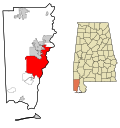South Lafayette Street Creole Cottages | |
| Location | Mobile, Alabama |
|---|---|
| Coordinates | 30°41′8″N88°4′17″W / 30.68556°N 88.07139°W |
| Built | 1852 |
| Architect | Multiple |
| Architectural style | Creole cottage |
| NRHP reference No. | 76000346 [1] |
| Added to NRHP | November 7, 1976 |
The South Lafayette Street Creole Cottages is a grouping of three historic Creole cottages on South Lafayette Street in Mobile, Alabama, United States. They were built in 1852. [2] All three were placed as a group on the National Register of Historic Places on November 7, 1976. [1]
South Lafayette Street Creole Cottages








